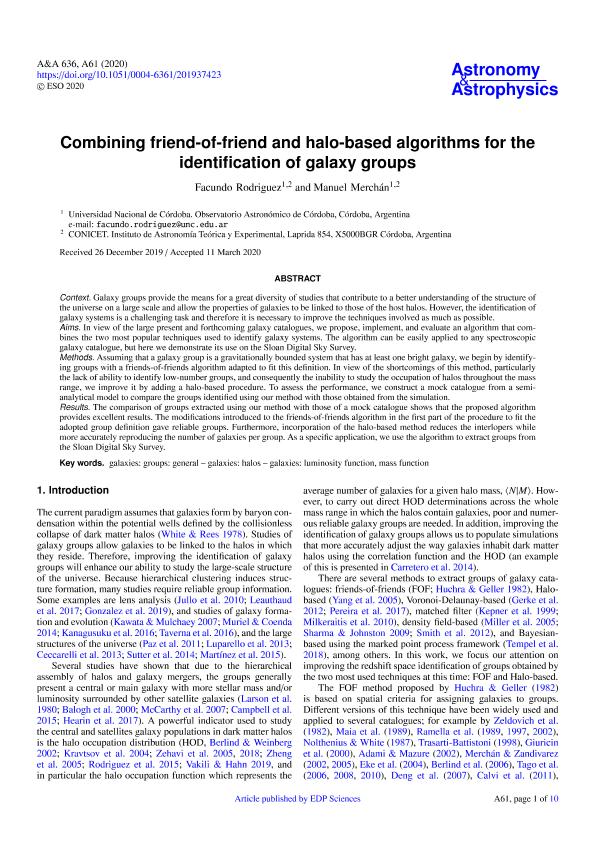Mostrar el registro sencillo del ítem
dc.contributor.author
Rodriguez, Facundo

dc.contributor.author
Merchan, Manuel Enrique

dc.date.available
2021-09-22T19:36:48Z
dc.date.issued
2020-04
dc.identifier.citation
Rodriguez, Facundo; Merchan, Manuel Enrique; Combining friend-of-friend and halo-based algorithms for the identification of galaxy groups; EDP Sciences; Astronomy and Astrophysics; 636; 4-2020; 1-10
dc.identifier.issn
0004-6361
dc.identifier.uri
http://hdl.handle.net/11336/141240
dc.description.abstract
Galaxy groups provide the means for a great diversity of studies that contribute to a better understanding of the structure ofthe universe on a large scale and allow the properties of galaxies to be linked to those of the host halos. However, the identification ofgalaxy systems is a challenging task and therefore it is necessary to improve the techniques involved as much as possible.Aims. In view of the large present and forthcoming galaxy catalogues, we propose, implement, and evaluate an algorithm that combines the two most popular techniques used to identify galaxy systems. The algorithm can be easily applied to any spectroscopicgalaxy catalogue, but here we demonstrate its use on the Sloan Digital Sky Survey.Methods. Assuming that a galaxy group is a gravitationally bounded system that has at least one bright galaxy, we begin by identifying groups with a friends-of-friends algorithm adapted to fit this definition. In view of the shortcomings of this method, particularlythe lack of ability to identify low-number groups, and consequently the inability to study the occupation of halos throughout the massrange, we improve it by adding a halo-based procedure. To assess the performance, we construct a mock catalogue from a semianalytical model to compare the groups identified using our method with those obtained from the simulation.Results. The comparison of groups extracted using our method with those of a mock catalogue shows that the proposed algorithmprovides excellent results. The modifications introduced to the friends-of-friends algorithm in the first part of the procedure to fit theadopted group definition gave reliable groups. Furthermore, incorporation of the halo-based method reduces the interlopers whilemore accurately reproducing the number of galaxies per group. As a specific application, we use the algorithm to extract groups fromthe Sloan Digital Sky Survey
dc.format
application/pdf
dc.language.iso
eng
dc.publisher
EDP Sciences

dc.rights
info:eu-repo/semantics/openAccess
dc.rights.uri
https://creativecommons.org/licenses/by-nc-sa/2.5/ar/
dc.subject
GALAXIES: GROUPS: GENERAL
dc.subject
GALAXIES: HALOS
dc.subject
GALAXIES: LUMINOSITY FUNCTION
dc.subject
MASS FUNCTION
dc.subject.classification
Astronomía

dc.subject.classification
Ciencias Físicas

dc.subject.classification
CIENCIAS NATURALES Y EXACTAS

dc.title
Combining friend-of-friend and halo-based algorithms for the identification of galaxy groups
dc.type
info:eu-repo/semantics/article
dc.type
info:ar-repo/semantics/artículo
dc.type
info:eu-repo/semantics/publishedVersion
dc.date.updated
2021-04-23T16:43:18Z
dc.identifier.eissn
1432-0746
dc.journal.volume
636
dc.journal.pagination
1-10
dc.journal.pais
Francia

dc.journal.ciudad
Paris
dc.description.fil
Fil: Rodriguez, Facundo. Consejo Nacional de Investigaciones Científicas y Técnicas. Centro Científico Tecnológico Conicet - Córdoba. Instituto de Astronomía Teórica y Experimental. Universidad Nacional de Córdoba. Observatorio Astronómico de Córdoba. Instituto de Astronomía Teórica y Experimental; Argentina
dc.description.fil
Fil: Merchan, Manuel Enrique. Consejo Nacional de Investigaciones Científicas y Técnicas. Centro Científico Tecnológico Conicet - Córdoba. Instituto de Astronomía Teórica y Experimental. Universidad Nacional de Córdoba. Observatorio Astronómico de Córdoba. Instituto de Astronomía Teórica y Experimental; Argentina
dc.journal.title
Astronomy and Astrophysics

dc.relation.alternativeid
info:eu-repo/semantics/altIdentifier/url/https://www.aanda.org/10.1051/0004-6361/201937423
dc.relation.alternativeid
info:eu-repo/semantics/altIdentifier/doi/http://dx.doi.org/10.1051/0004-6361/201937423
Archivos asociados
